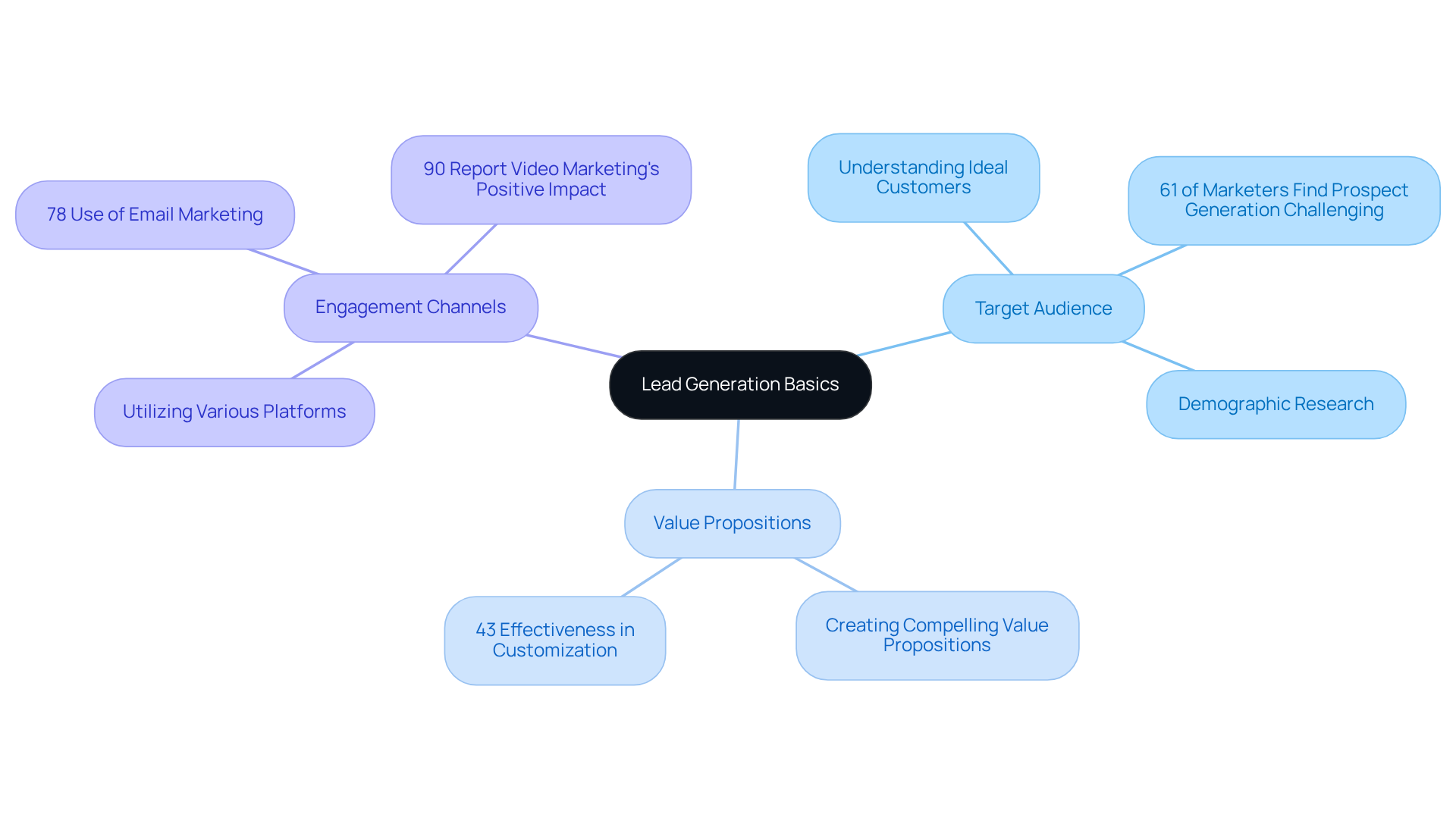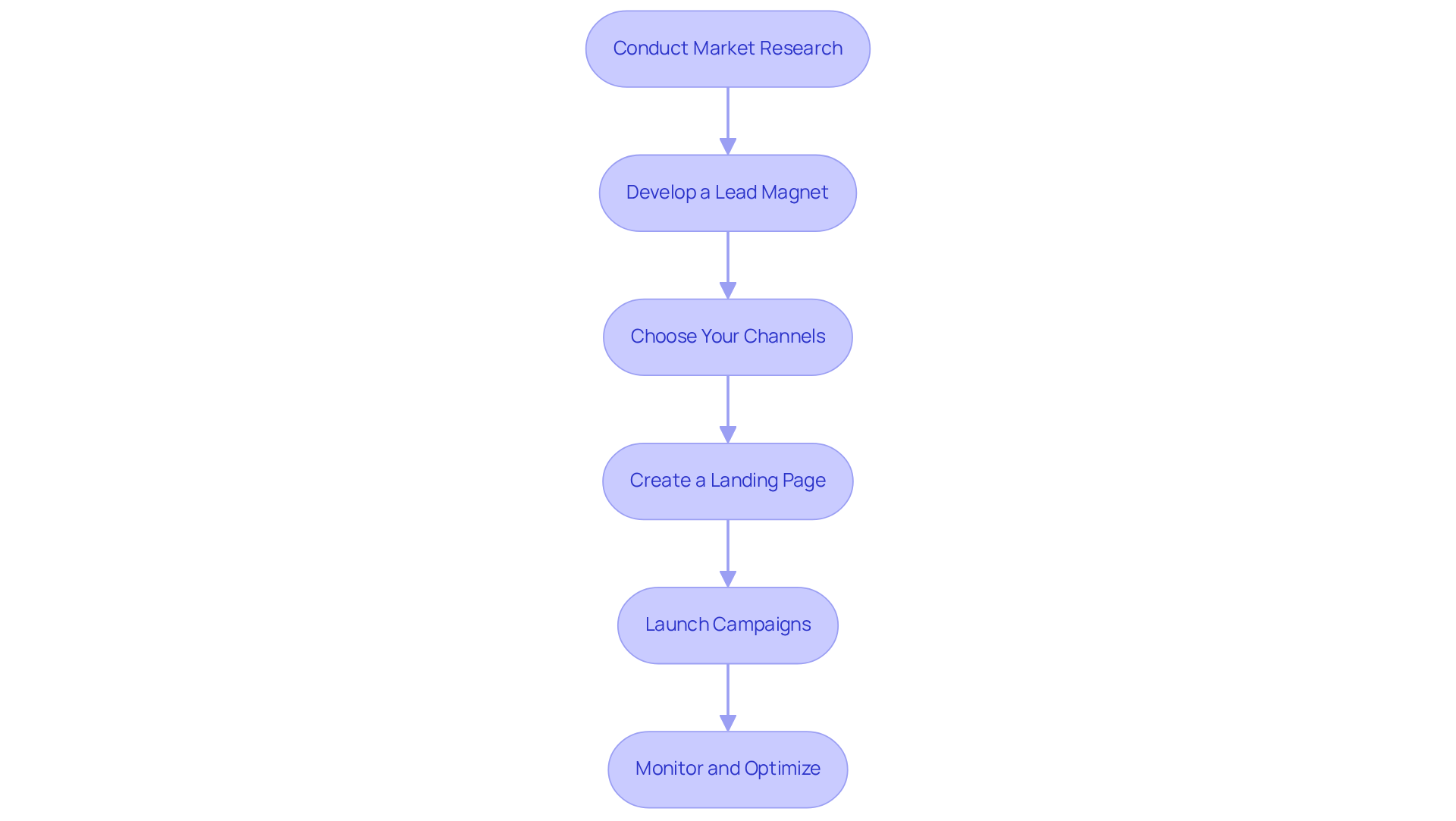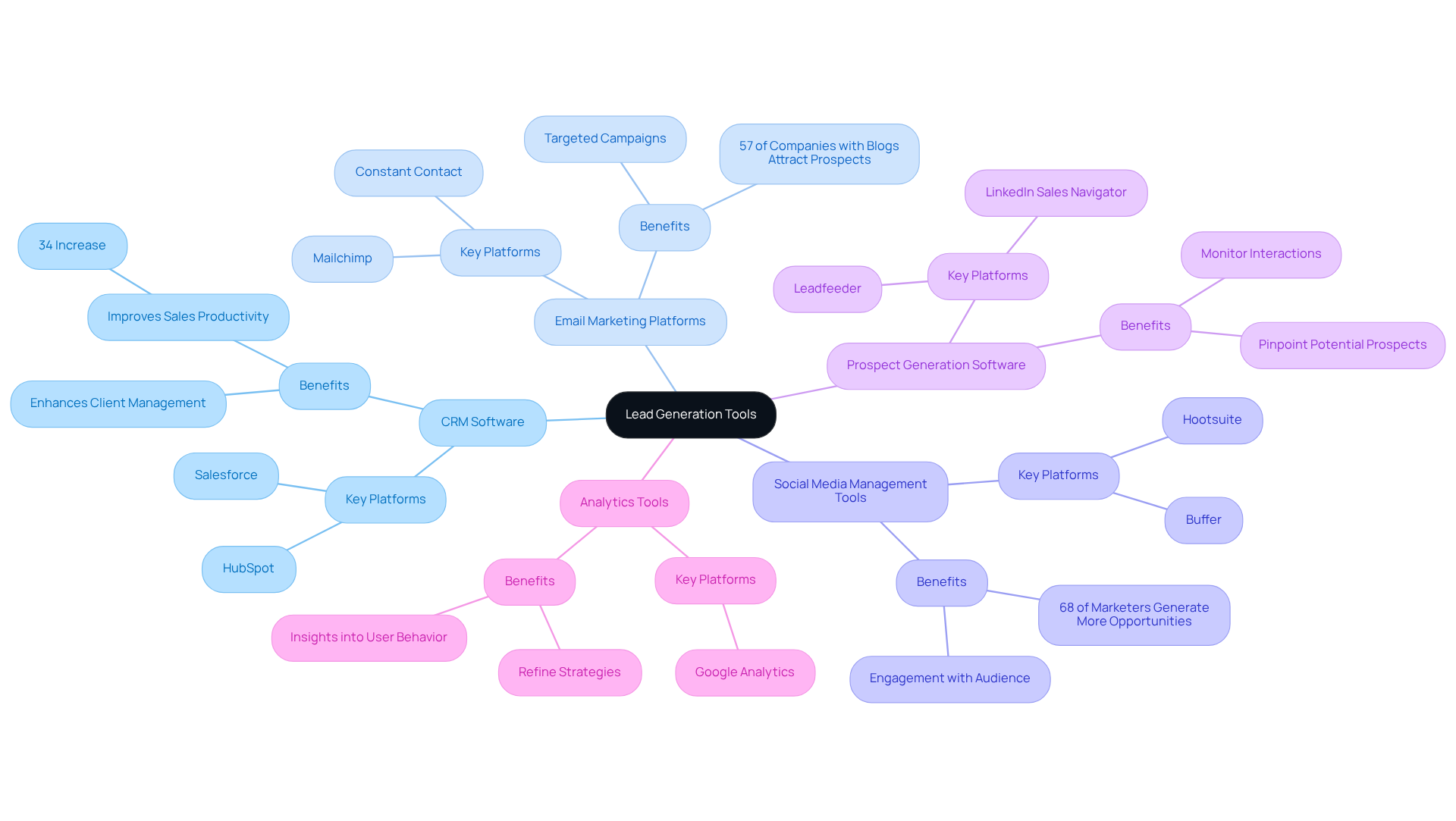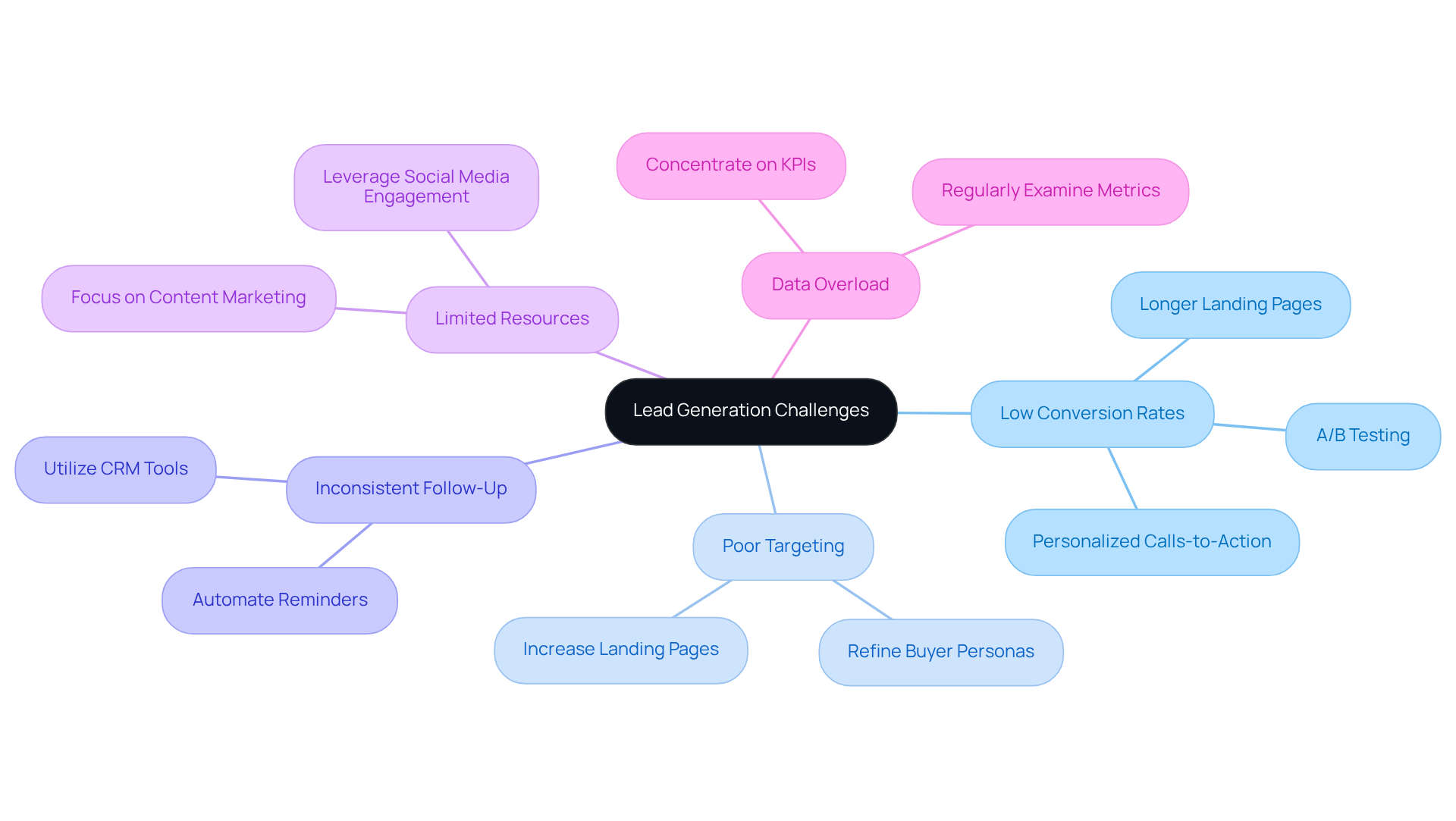Overview
Lead generation is a vital process that involves attracting and nurturing potential customers through thoughtful strategies designed to create awareness and interest in your product or service.
We understand your challenges in reaching your audience, and that’s why it’s crucial to know who they are.
By crafting compelling value propositions and utilizing various engagement channels, you can effectively connect with them.
Statistics show that these methods can successfully guide prospects through the sales funnel, leading to meaningful interactions and conversions.
Together, we can explore how to make these strategies work for you.
Introduction
Lead generation is a vital aspect for small businesses looking to flourish in today’s competitive markets. By grasping the nuances of attracting and nurturing potential customers, you can open doors to growth and increased sales. Yet, many marketers face the daunting challenge of prospect generation.
How can small enterprises effectively navigate this complex landscape? This guide will explore essential steps, strategies, and tools that will help you master lead generation. Together, we can ensure that your business not only attracts the right audience but also transforms them into loyal customers.
Understand Lead Generation Basics
To define lead generation, one must recognize that it involves not only attracting potential customers but also nurturing relationships with individuals who have shown interest in your product or service. This process involves various strategies designed to define lead generation by creating awareness and interest, ultimately guiding prospects through the sales funnel. Let's explore some key components together:
- Identifying Your Target Audience: Understanding who your ideal customers are is essential. This means diving into demographic research and analyzing customer behavior. It's important to note that a considerable 61% of marketers recognize prospect generation as their main challenge. This concern resonates with many small business owners who often face similar obstacles in effectively reaching the right group.
- Creating Compelling Value Propositions: Clearly articulating what makes your product or service unique and beneficial to potential customers is crucial. Customization in communication can significantly enhance involvement. In fact, 43% of U.S. marketers acknowledge its effectiveness in generating high-quality prospects.
- Engagement Channels: Utilizing a variety of platforms—such as social media, email, and content marketing—allows you to reach and engage your audience effectively. Notably, 78% of companies leverage email marketing as their primary strategy for acquiring prospects, and 42% still view it as the most effective approach for attracting clients. Furthermore, 90% of marketers report that video marketing has positively influenced prospect development, underscoring the importance of incorporating diverse content types.
By mastering these fundamentals, you can create a solid foundation for your client acquisition efforts, ensuring that you attract the right prospects and enhance your sales potential. Remember, prompt follow-ups are crucial; 44% of sales representatives express concerns about the quality of incoming prospects. This highlights the necessity for swift responses to optimize your chances of conversion. Together, we can navigate these challenges and achieve success.

Implement the Lead Generation Process
To effectively implement the lead generation process, let's explore some essential steps together:
-
Conduct Market Research: It's vital to understand the needs, preferences, and pain points of your target demographic. Consider utilizing surveys, interviews, and analytics tools to gather data. Did you know that 63% of businesses define lead generation as their biggest marketing challenge? Additionally, 47% of researchers worldwide regularly use AI in their market research activities, highlighting a growing trend. Understanding where your target group 'lives' online is crucial for tailoring your approach to meet their needs.
-
Develop a Lead Magnet: Create valuable content, such as eBooks, webinars, or free trials, that encourages prospects to share their contact information. Gated content, like webinars, has proven to generate high-quality leads, helping to define lead generation, with 89% of marketers believing that webinars create more qualified leads than any other channel. Together, we can craft something truly engaging.
-
Choose Your Channels: Selecting the most effective platforms for reaching your audience is key. Consider options like social media, email marketing, or SEO. With 70% of consumers opting to receive texts from businesses, integrating mobile messaging can significantly enhance your outreach efforts.
-
Create a Landing Page: Design a dedicated landing page that showcases your promotional magnet and includes a clear call-to-action (CTA). Did you know that landing pages can achieve conversion rates as high as 160% compared to other sign-up forms? Moreover, 36% of landing pages featuring testimonials are more effective in conversions, so including social proof can be a game changer.
-
Launch Campaigns: Utilize your selected channels to promote your magnet and direct traffic to your landing page. Consistent interaction across multiple platforms can greatly enhance your efforts to define lead generation. Remember, every step counts!
-
Monitor and Optimize: Tracking key metrics, such as conversion rates and traffic sources, is essential to evaluate the effectiveness of your campaigns. Continuous improvement is crucial, as 78% of sales teams indicate that webinars help reduce the cost per potential client. Together, we can enhance your strategies gradually, ensuring success over time.

Utilize Tools and Resources for Effective Lead Generation
To optimize your lead generation efforts, it's essential to leverage the right tools and resources that can truly make a difference for your business:
- CRM Software: Platforms like HubSpot and Salesforce are invaluable for managing leads, tracking interactions, and analyzing customer data. Did you know that research indicates CRM systems can improve sales productivity by as much as 34%? This makes them essential for small enterprises looking to enhance their client management processes.
- Email Marketing Platforms: Services such as Mailchimp and Constant Contact empower you to create targeted email campaigns and automate follow-ups. Consider this: 57% of companies with a blog attract prospects from their content. This highlights the importance of combining email marketing with content strategies to enhance your outreach.
- Social Media Management Tools: Tools like Hootsuite and Buffer allow you to schedule posts, engage with your audience, and analyze social media performance. With 68% of marketers indicating that social media has helped them generate more opportunities, these platforms are crucial for establishing a strong online presence.
- Prospect Generation Software: Tools such as LinkedIn Sales Navigator and Leadfeeder assist in pinpointing potential prospects and monitoring their interactions with your content. This targeted strategy is essential for small enterprises aiming to engage with the right audience. Additionally, Wayy.ai offers a one-click sales playbook and focused outreach features that can significantly enhance your prospecting strategy.
- Analytics Tools: Google Analytics and similar platforms provide insights into website traffic and user behavior, allowing you to refine your strategies effectively. A data-driven approach improves prospect acquisition efficiency, enabling you to make informed choices based on customer interactions. Wayy.ai also provides daily email updates featuring key metrics, including how many prospects were reached, who expressed interest, and how conversion rates are improving.
By thoughtfully incorporating these tools into your prospecting strategy, especially with insights from Wayy.ai, you can streamline your operations and enhance your outreach. Together, we can achieve success in defining lead generation efforts.

Troubleshoot Common Lead Generation Challenges
Common lead generation challenges can feel overwhelming, but addressing them is a vital step toward success. Let's explore these challenges together and find ways to overcome them.
-
Low Conversion Rates: If your landing page isn't converting effectively, it might be time to consider A/B testing for elements like headlines, calls-to-action (CTAs), and layouts. Research shows that a longer landing page can achieve up to 37.5% more conversions. This highlights the importance of testing different formats to discover what resonates with your audience.
-
Poor Targeting: Are you reaching the right audience? Take a moment to revisit and refine your buyer personas. Precise targeting is essential; businesses with 31 to 40 landing pages generate seven times more inquiries than those with just 1-5 pages. This underscores the need for a thoughtful approach to audience segmentation, ensuring your efforts are directed where they matter most.
-
Inconsistent Follow-Up: Nurturing prospects effectively is crucial. Establishing a robust follow-up system can make all the difference. Consider utilizing CRM tools to automate reminders and follow-up emails, ensuring that no potential client slips through the cracks. Consistent engagement is key to transforming prospects into loyal customers.
-
Limited Resources: We understand that time and budget constraints can be challenging. When faced with these limitations, focus on high-impact strategies like content marketing or social media engagement. These methods often require less financial investment while still delivering significant results.
-
Data Overload: Are you feeling overwhelmed by data? Concentrate on key performance indicators (KPIs) that align with your organizational objectives. Regularly examining these metrics can help you avoid feeling inundated, enabling you to make informed decisions that foster success in acquiring new clients.
By proactively addressing these challenges, you can significantly enhance your efforts to define lead generation and achieve the results you desire. Remember, you are not alone in this journey; together, we can navigate these obstacles and find success.

Conclusion
Defining lead generation is essential for small businesses striving to thrive in a competitive marketplace. This process goes beyond merely attracting potential customers; it’s about nurturing lasting relationships with those who express interest in your offerings. By grasping the fundamentals of lead generation, businesses can effectively create awareness, engage their target audience, and guide prospects through the sales funnel.
Throughout this article, we’ve outlined key strategies that resonate with your journey, including:
- Identifying target audiences
- Crafting compelling value propositions
- Utilizing diverse engagement channels
- Implementing effective tools and resources
Each of these components plays a vital role in optimizing lead generation efforts, emphasizing the importance of continuous improvement and monitoring to enhance conversion rates. Moreover, by addressing common challenges such as low conversion rates and poor targeting, you can significantly influence the success of your lead generation initiatives.
Ultimately, the significance of lead generation cannot be overstated. It serves as the backbone of any successful marketing strategy, allowing you to connect with the right audience and convert prospects into loyal customers. By actively implementing the strategies discussed and leveraging available tools, small businesses can navigate the complexities of lead generation and position themselves for long-term growth and success. Embracing these practices not only strengthens client acquisition efforts but also fosters a deeper understanding of customer needs, paving the way for a more resilient and responsive business model. Together, we can achieve success in this vital aspect of your business.
Frequently Asked Questions
What is lead generation?
Lead generation involves attracting potential customers and nurturing relationships with individuals who have shown interest in your product or service, guiding them through the sales funnel.
Why is identifying your target audience important in lead generation?
Understanding your ideal customers through demographic research and behavior analysis is essential because it helps effectively reach the right group, which is a significant challenge for many marketers.
What percentage of marketers consider prospect generation their main challenge?
61% of marketers recognize prospect generation as their main challenge.
How can creating compelling value propositions help in lead generation?
Clearly articulating what makes your product or service unique and beneficial enhances customer involvement, with 43% of U.S. marketers acknowledging its effectiveness in generating high-quality prospects.
What engagement channels are effective for lead generation?
Utilizing a variety of platforms such as social media, email, and content marketing is effective for reaching and engaging your audience.
What percentage of companies use email marketing for acquiring prospects?
78% of companies leverage email marketing as their primary strategy for acquiring prospects.
How effective is video marketing in prospect development?
90% of marketers report that video marketing has positively influenced prospect development.
Why are prompt follow-ups important in lead generation?
Prompt follow-ups are crucial because 44% of sales representatives express concerns about the quality of incoming prospects, highlighting the need for swift responses to optimize conversion chances.




